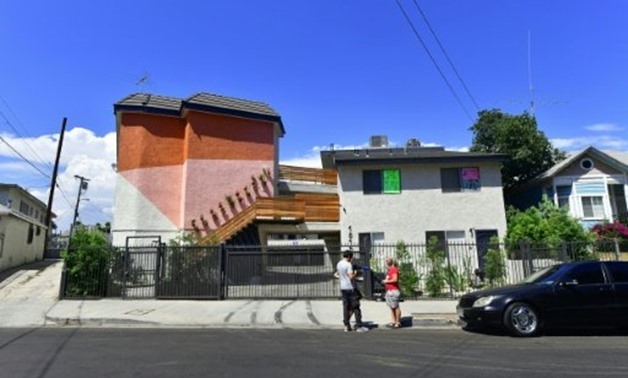
Boyle Heights neighborhood of Los Angeles, California, where pending gentrification and increasing rent is sparking concern among longtime residents
LOS ANGELES - 20 August 2017: One morning, Los Angeles businesswoman Eva Chimento was about to open her art gallery in the city's Hispanic enclave of Boyle Heights when she found the door slightly open.
While puzzled, she didn't think much of the incident until a second occasion when she found the lock had been forced.
She was later invited by a group of women calling themselves the Ovarian Psychos to a community meeting "to talk about gentrification," but encountered hostility and verbal abuse when she stood up to talk.
"It was horrible, I was insulted," says Chimento, who believes the incidents are part of a larger pattern of harassment from community activists trying to halt an influx of affluent residents.
Mihai Nicodim, a neighboring gallery owner, has had his door vandalized and his store front defaced with insulting slogans such as "fuck white art," while exhibition openings have been met with protests.
"All the while I had a Chinese artist on display. I represent a South African, local artists," said Nicodim, who has lived in Boyle Heights for decades, since arriving in the US as a penniless Romanian refugee.
The entrepreneurs are among a growing number of aggrieved in an escalating battle between the burgeoning galleries, coffee shops and other new businesses -- and activists who fear their community is being threatened by a wave of gentrification.
A few hundred meters (yards) from the galleries lives Irma Aguilar, who has just seen her rent jump from $1,000 to $1,800 a month and risks losing the apartment she has called home for 20 years.
"What do they want us to do with art galleries? We are not going to buy paintings. Our community needs schools," says the 43-year-old.
- Too 'hipster' -
Gentrification -- a gradual process of transforming an area to appeal more to middle-class tastes -- often begins with the arrival of artists and galleries in search of vast spaces with low rents.
Then come the trendy shops and restaurants and, in the long term, rents soar and the original inhabitants are forced to leave.
"Historically, the inner cities of Los Angeles have been working class and poor. Rich people were living in the suburbs, further out," says urban planner and activist James Rojas.
"Now, young rich people want to move back to the city. It started in the early 2000s."
Los Angeles, which is experiencing a real estate boom and a housing and homelessness crisis, has seen its downtown sector, once a no-man's land, become one of the most vibrant neighborhoods in the country.
Boyle Heights, a few miles (kilometers) away, is the logical progression.
Tension between the established community and newcomers was ratcheted up a few weeks ago with the opening of Weird Wave Coffee, its long counter and walls decorated with work by local artists, and a poster of Filipino boxer Manny Pacquiao.
Some locals weren't exactly happy to see the place, judging it too "hipster" and ensuring it was welcomed to the neighborhood with protests and vandalized windows.
"We're not trying to gentrify the neighborhood -- we couldn't do it even if we tried -- we're just here to sell coffee," says Jackson Defa, one of the three partners in the business.
- Rebellion -
Despite its problems, Defa says he doesn't regret having chosen Boyle Heights for his business.
"After our windows were vandalized, the whole neighborhood donated money to pay for the repairs," he reveals.
"People would like to picture that we are not welcome, but the facts are different."
For others, like art gallery Pssst, the harassment has already become too much and the business has shut down.
The development was welcomed as a victory by "Defend Boyle Heights," a group of activists at the forefront of the rebellion against gentrification.
Chimento, who opened her gallery with a small budget to satisfy her passion for art, has no intention of following suit.
A single mother, she says she understands the need for affordable housing, but emphasizes the need for "dialogue and compromise" and plans on staying put.
Other residents are fatalistic in the face of what they see as an irresistible influx of gentrifying businesses.
Elizabeth Blaney, a member of the local residents' association, says no one wanted the types of businesses that have contributed to the gentrification of the neighborhood.
"They said, 'We need a laundromat' and instead they get a gallery; 'places for youth or seniors,' and they get breweries. That's not what the people are asking for," she told AFP.
She added that while vandalism and violence are wrong, people need to be aware that the campaigners are "fighting for their home and this basic need is being taken away from them."
"These businesses are known as gentrifying businesses and it's about who they attract. And they attract developers who increase the rents."


Comments
Leave a Comment